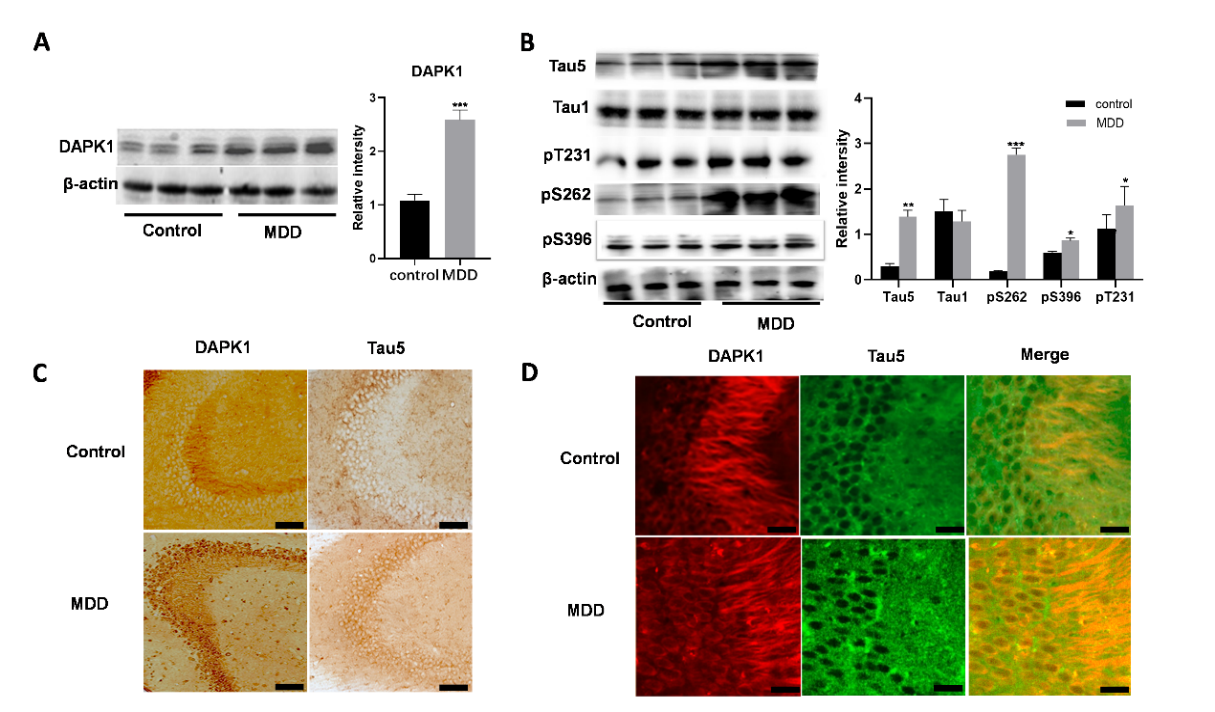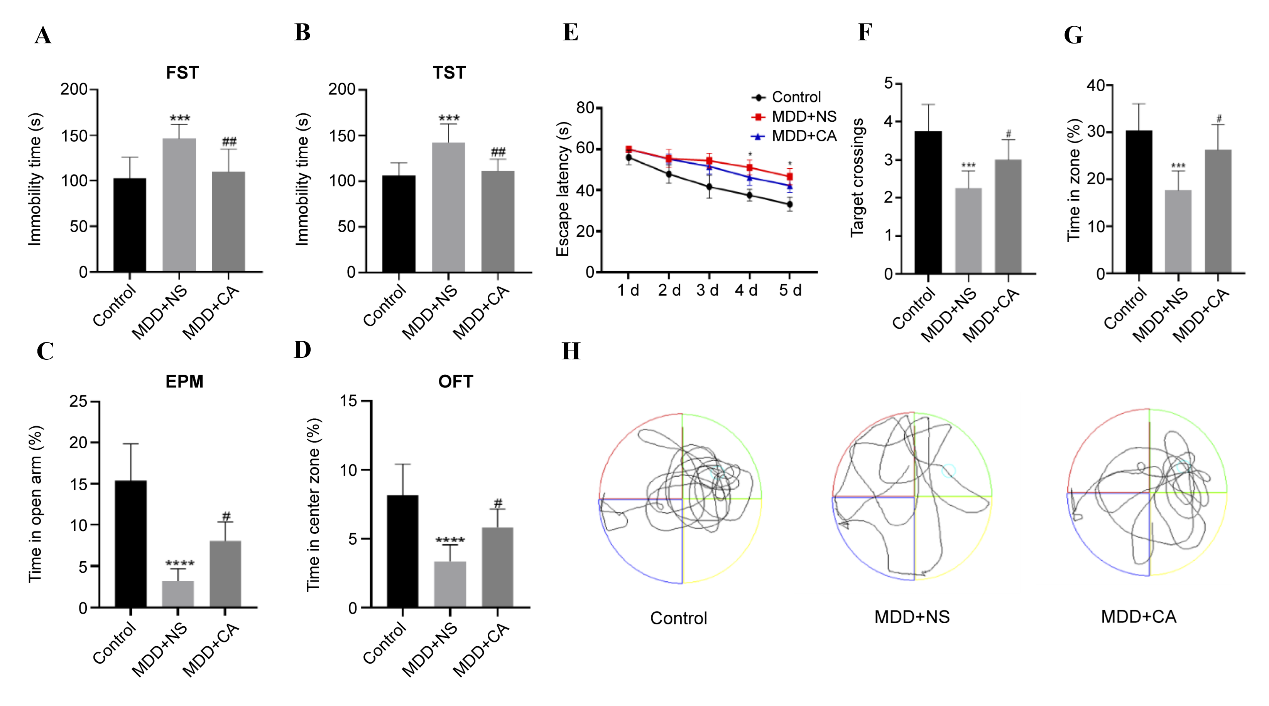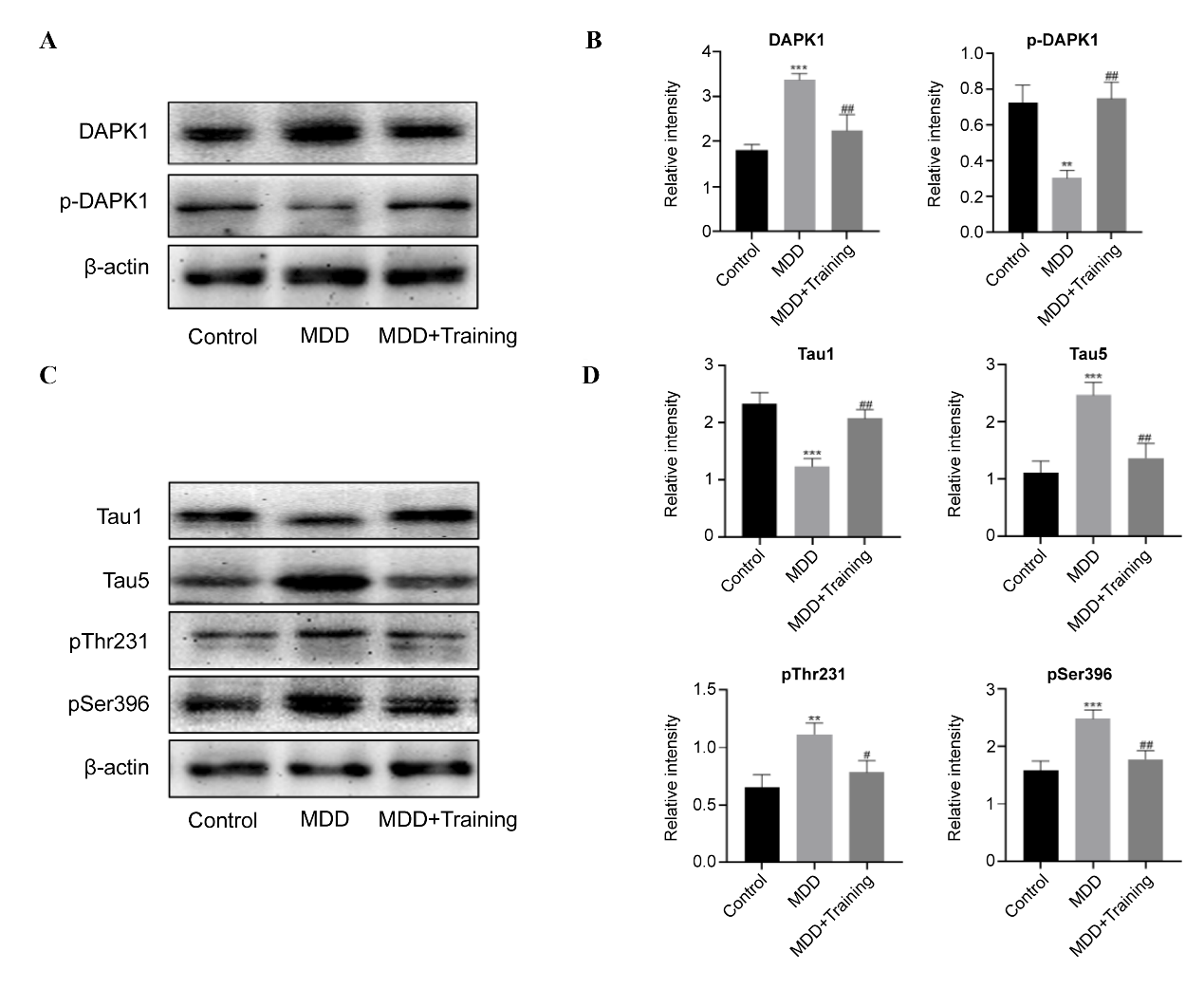NRR:郑州大学段东晓研究团队提出死亡相关蛋白激酶1是引起重度抑郁认知功能障碍的潜在因素
撰文:段东晓
抑郁是一类常见的精神疾病,至今为止全球患者已超过3.5亿。据世界卫生组织预测,到2030年抑郁将成为全球第一大类疾病[1, 2]。认知功能障碍是重度抑郁的重要特征之一。重度抑郁患者存在思维迟钝、学习记忆能力下降、情绪低落和不愿活动等症状[3]。目前对重度抑郁中认知功能障碍的研究逐渐增多,但主要集中在记忆功能和执行功能方面,且其具体机制仍然不清。认知障碍常见于阿尔茨海默症。研究发现,阿尔茨海默症与抑郁之间存在着紧密相关性。抑郁是阿尔茨海默症的高危诱发因素和前期临床表现,二者具有一定的共病基础,如情绪改变、认知功能下降等[4-6]。死亡相关蛋白激酶1(death-associated protein kinase 1,DAPK1)是一种钙/钙调蛋白调节的丝氨酸/苏氨酸激酶,能在阿尔茨海默症Tau蛋白磷酸化中起重要作用,且与阿尔茨海默症认知功能的改变密切相关[7, 8]。郑州大学段东晓团队既往研究发现重度抑郁小鼠模型海马中DAPK1表达增加,但该蛋白的变化是否与重度抑郁认知功能障碍有关,值得探讨。
近期段东晓团队在《中国神经再生研究(英文版)》(Neural Regeneration Research)上发表了题为“Death-associated protein kinase 1 is associated with cognitive dysfunction in major depressive disorder”的研究,发现使用社会孤立和慢性压力刺激制备的重度抑郁小鼠模型中,海马CA3区DAPK1和Tau蛋白表达水平增加,且Tau蛋白在Thr231,Ser262和Ser396位点出现过度磷酸化;此外,DAPK1在神经元中的表达和定位,从神经元轴突表达较多,转变为细胞膜和胞浆的过表达,且Tau蛋白的表达变化与DAPK1一致。而经运动和抗抑郁药物治疗后,抑郁症状和认知功能障碍明显改善,且DAPK1表达及Tau蛋白磷酸化显著减轻。表明DAPK1参与重度抑郁认知功能的变化。
重度抑郁的病因很复杂,包括自身个性、遗传因素、疾病因素和环境不良刺激等。随着人们环境改变压力增加及不良因素的刺激增多,重度抑郁的患病率具有快速增长的趋势[9-11]。因此,段东晓等使用雄性C57BL/C小鼠以社会隔离和慢性应激方法构建了重度抑郁模型,并以经典的抗抑郁药物西酞普兰以及典型的辅助疗法运动进行治疗。经行为学和组织学检测评估认知功能障碍后DAPK1表达变化以及机制。结果发现,重度抑郁小鼠表现出明显的抑郁样行为和认知功能障碍,其海马组织中DAPK1和Tau相关蛋白发生显著变化(图1),而经运动和药物治疗后,小鼠的抑郁样行为有所缓解,认知功能得到改善(图2),且海马中DAPK1表达以及磷酸化Tau蛋白表达减少(图3)。这些结果表明,重度抑郁小鼠的认知功能障碍可能与海马组织中DAPK1的表达和分布有关。
 #br#
图1:重度抑郁小鼠模型海马组织中DAPK1和Tau蛋白的表达(图源:Li et al., Neural Regen Res, 2023)
#br#
图1:重度抑郁小鼠模型海马组织中DAPK1和Tau蛋白的表达(图源:Li et al., Neural Regen Res, 2023)
 #br#
图2:西酞普兰对重度抑郁小鼠模型抑郁行为和认知障碍的影响(图源:Li et al., Neural Regen Res, 2023)
#br#
图2:西酞普兰对重度抑郁小鼠模型抑郁行为和认知障碍的影响(图源:Li et al., Neural Regen Res, 2023)
 #br#
图3 运动对重度抑郁小鼠模型海马组织中DAPK1和Tau蛋白表达的影响(图源:Li et al., Neural Regen Res, 2023)
#br#
图3 运动对重度抑郁小鼠模型海马组织中DAPK1和Tau蛋白表达的影响(图源:Li et al., Neural Regen Res, 2023)
综上所述,DAPK1与重度抑郁小鼠的认知功能障碍存在着一定的关联。该研究中一个有趣发现是,药物和运动都是治疗抑郁和认知功能障碍的有效方法,这2种方法都可改善抑郁症状,降低Tau蛋白磷酸化和DAPK1表达。未来可通过DAPK1抑制剂、病毒转染敲减DAPK1基因、DAPK1转基因小鼠探索抑郁和认知功能的改善是否与DAPK1直接相关。#br#
#br#
原文链接:https://doi.org/10.4103/1673-5374.361532#br#
#br#
参考文献#br#
[1] Woelfer M, Kasties V, Kahlfuss S, et al. The role of depressive subtypes within the neuroinflammation hypothesis of major depressive disorder. Neuroscience. 2019;403:93-110.#br#
[2] Athira KV, Bandopadhyay S, Samudrala PK, et al. An overview of the heterogeneity of major depressive disorder: current knowledge and future prospective. Curr Neuropharmacol. 2020;18(3):168-187.#br#
[3] Pan Z, Park C, Brietzke E, et al. Cognitive impairment in major depressive disorder. CNS Spectr. 2019;24(1):22-29.#br#
[4] Berger T, Lee H, Young AH, et al. Adult hippocampal neurogenesis in major depressive disorder and Alzheimer's disease. Trends Mol Med. 2020;26(9):803-818.#br#
[5] Herbert J, Lucassen PJ. Depression as a risk factor for Alzheimer's disease: genes, steroids, cytokines and neurogenesis - What do we need to know? Front Neuroendocrinol. 2016;41:153-171.#br#
[6] Steck N, Cooper C, Orgeta V. Investigation of possible risk factors for depression in Alzheimer's disease: A systematic review of the evidence. J Affect Disord. 2018;236:149-156.#br#
[7] Xu LZ, Li BQ, Jia JP. DAPK1: a novel pathology and treatment target for Alzheimer's disease. Mol Neurobiol. 2019;56(4):2838-2844.#br#
[8] Kim N, Chen D, Zhou XZ, et al. Death-associated protein kinase 1 phosphorylation in neuronal cell death and neurodegenerative disease. Int J Mol Sci. 2019;20(13):3131.#br#
[9] Otte C, Gold SM, Penninx BW, et al. Major depressive disorder. Nat Rev Dis Primers. 2016;2:16065.#br#
[10] Balestri M, Porcelli S, Souery D, et al. Temperament and character influence on depression treatment outcome. J Affect Disord. 2019;252:464-474.#br#
[11] Snijders G, Mesman E, De Wit H, et al. Immune dysregulation in offspring of a bipolar parent. Altered serum levels of immune growth factors at adolescent age. Brain Behav Immun. 2017;64:116-123.#br#
#br#
#br#
 #br#
#br#
照片提供自郑州大学神经疾病研究实验室#br#
该实验室长期致力于神经退行性疾病的研究,已取得了多项基金的支持。本课题由河南省科技厅科技攻关项目2项资助,李晓慧和朱红灿为文章的共同第一作者,段东晓为通讯作者。
#br#
#br#
照片提供自郑州大学神经疾病研究实验室#br#
该实验室长期致力于神经退行性疾病的研究,已取得了多项基金的支持。本课题由河南省科技厅科技攻关项目2项资助,李晓慧和朱红灿为文章的共同第一作者,段东晓为通讯作者。
 #br#
图1:重度抑郁小鼠模型海马组织中DAPK1和Tau蛋白的表达(图源:Li et al., Neural Regen Res, 2023)
#br#
图1:重度抑郁小鼠模型海马组织中DAPK1和Tau蛋白的表达(图源:Li et al., Neural Regen Res, 2023)
 #br#
图2:西酞普兰对重度抑郁小鼠模型抑郁行为和认知障碍的影响(图源:Li et al., Neural Regen Res, 2023)
#br#
图2:西酞普兰对重度抑郁小鼠模型抑郁行为和认知障碍的影响(图源:Li et al., Neural Regen Res, 2023)
 #br#
图3 运动对重度抑郁小鼠模型海马组织中DAPK1和Tau蛋白表达的影响(图源:Li et al., Neural Regen Res, 2023)
#br#
图3 运动对重度抑郁小鼠模型海马组织中DAPK1和Tau蛋白表达的影响(图源:Li et al., Neural Regen Res, 2023)
 #br#
#br#
照片提供自郑州大学神经疾病研究实验室#br#
该实验室长期致力于神经退行性疾病的研究,已取得了多项基金的支持。本课题由河南省科技厅科技攻关项目2项资助,李晓慧和朱红灿为文章的共同第一作者,段东晓为通讯作者。
#br#
#br#
照片提供自郑州大学神经疾病研究实验室#br#
该实验室长期致力于神经退行性疾病的研究,已取得了多项基金的支持。本课题由河南省科技厅科技攻关项目2项资助,李晓慧和朱红灿为文章的共同第一作者,段东晓为通讯作者。